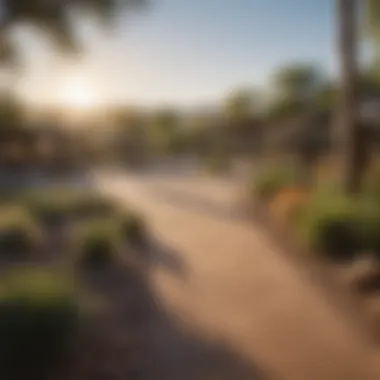Where to Live in Phoenix: An In-Depth Analysis


Intro
Phoenix, Arizona, is not just a city; it is a complex tapestry of neighborhoods, each offering distinct lifestyles, amenities, and atmospheres. As one of the largest cities in the United States, it presents a myriad of options for those considering relocation. This article serves as an exploration into where to live in Phoenix, catering to diverse lifestyle preferences while providing detailed insights that extend beyond simple reviews.
Understanding Phoenix's neighborhoods requires assessing various factors, including housing costs, school quality, recreational facilities, and overall appeal. Such criteria assist potential residents in navigating their choices. The analysis is structured to deliver insightful content aimed at real estate enthusiasts, travel lovers, and aficionados of interior design, ensuring that readers can make informed decisions based on their priorities in this dynamic urban landscape.
Foreword to Phoenix Living
Living in Phoenix is a choice that many make for various reasons, from its warm climate to the vibrant culture. This section explores the general experience of residing in the city. From the urban bustle of downtown to the calm of suburban life, Phoenix offers a range of living options. It is crucial to understand how different parts of the city affect lifestyle, cost, and social opportunities.
The unique geography of Phoenix also plays a significant role in how residents experience the area. The surrounding mountains and desert landscapes provide not only beautiful scenery but also countless outdoor activities that appeal to different lifestyle preferences.
Understanding these dynamics can greatly enhance one’s living experience in Phoenix.
Understanding the Phoenix Landscape
Phoenix is characterized by a sprawling landscape. The city is part of the Sonoran Desert, which influences both the climate and the lifestyle of residents. This means hot summers and mild winters, which affects outdoor activities and lifestyle choices. The topography is diverse, with mountains like South Mountain and Camelback Mountain, providing excellent hiking and biking opportunities.
The metropolitan area is divided into different neighborhoods, each with its distinct character. For example, areas like Downtown Phoenix are known for their cultural offerings and nightlife, whereas neighborhoods like Ahwatukee provide a more tranquil suburban environment.
In looking at the cityscape, one will find a mixture of residential and commercial zones. This includes everything from high-rise apartments in the core urban areas to family homes in the suburbs. Such a blend allows for a variety of living situations and influences social interactions.
Significance of Location in Phoenix
Location is perhaps one of the most critical factors when choosing where to live in Phoenix. Proximity to amenities such as schools, shopping centers, and workplaces can vary greatly from one neighborhood to another. For families, locating near quality schools and parks is often a top priority.
Conversely, young professionals might prefer living in urban settings for their nightlife options and accessibility to public transportation.
Furthermore, understanding the potential for long-term growth in a specific area can guide decisions. Some neighborhoods are experiencing revitalization, which can positively impact property values over time. Thus, evaluating the significance of location is vital for anyone considering a move to this dynamic city.
"Choosing the right neighborhood in Phoenix can make all the difference in terms of lifestyle satisfaction and property investment."
This section builds the foundation for deeper exploration into specific neighborhoods, housing market insights, and lifestyle factors that define living in Phoenix.
Overview of Phoenix Neighborhoods
Understanding the neighborhoods in Phoenix is vital for anyone considering a move to this city. Each neighborhood has distinct characteristics, catering to various lifestyles, preferences, and budgets. With a growing population, the dynamics of these areas are continually evolving. Knowing the strengths and weaknesses of different neighborhoods aids potential residents in making informed decisions.
Navigating Phoenix's diverse neighborhoods can also reveal hidden gems that one might overlook otherwise. This overview will explore three primary categories: core urban areas, suburban communities, and emerging neighborhoods. Each section focuses on the unique aspects that make these locations appealing and practical for various lifestyles.
Core Urban Areas
The core urban areas of Phoenix represent a vibrant mix of culture, history, and modern amenities. This region includes neighborhoods such as Downtown Phoenix and Roosevelt Row. Here, residents enjoy close proximity to art galleries, restaurants, and nightlife.
Core urban areas are essential for understanding the heart of the city. Residents in these districts often appreciate the convenience of having everything within walking distance.
Key elements to consider in core urban areas include:
- Cultural Attractions: Presence of museums, theaters, and art spaces.
- Public Transportation: Access to the Valley Metro system facilitates commuting.
- Economic Opportunities: Many businesses thrive in urban settings, leading to more job options.
Suburban Communities
Suburban communities around Phoenix offer a more tranquil setting, often appealing to families and retirees. Neighborhoods like Scottsdale and Chandler provide a quieter lifestyle while still being within reach of urban conveniences.
Suburban living benefits include:
- Family-Friendly Environment: Many suburbs prioritize green spaces and schools.
- Community Engagement: Suburbs often have local events fostering neighborly connections.
- Real Estate Options: A variety of housing types are available, from single-family homes to townhouses.
Emerging Neighborhoods
The concept of emerging neighborhoods caters to early adopters and those looking for investment opportunities. Areas like South Phoenix and Alhambra show significant promise for growth and development.
Such neighborhoods frequently attract a diverse demographic drawn to affordable housing prices and potential for appreciation.
Reasons to consider emerging neighborhoods include:


- Value for Money: Often less expensive compared to established areas.
- Potential Growth: New businesses and amenities may be on the rise.
- Diverse Communities: Many emerging areas have rich cultural diversity.
In summary, an overview of Phoenix neighborhoods highlights diverse living options tailored to different life choices. Understanding these neighborhoods allows potential residents to align their priorities with the right location.
Housing Market Insights
Understanding the housing market in Phoenix is essential for anyone contemplating a life change in this city. The housing dynamics can significantly influence your choices on where to live, impacting budget, lifestyle, and long-term investment. Phoenix has seen a fluctuating market in recent years. Many factors come into play, making it necessary to comprehend current trends, price points, and rental conditions.
Current Market Trends
The Phoenix housing market has experienced notable shifts. Demand has surged, partly due to an influx of new residents escaping costly metropolitan areas like San Francisco and Los Angeles. The pandemic also prompted remote work opportunities, allowing individuals to seek homes in locations offering more space and favorable weather.
As of now, market trends are characterized by decreased inventory and increased buyer competition. This results in bidding wars, often driving prices higher. Homes are selling quickly, sometimes within days of listing. Additionally, the market for new constructions is growing, with several developers capitalizing on this demand, focusing on energy-efficient and modern designs. Supply chain issues have, however, inhibited some projects, prolonging delivery times.
Average Home Prices
The average home price in Phoenix reflects its desirability. As of 2023, prices hover around $400,000, which is a significant rise compared to previous years. When examining different neighborhoods, prices can vary considerably.
- Downtown Phoenix: Prices often exceed $500,000 due to urban attractions and amenities.
- Scottsdale: This neighborhood caters to luxury buyers, with average prices well over $700,000.
- Chandler and Tempe: Both areas tend to offer homes in the $350,000 to $500,000 range, appealing to families and professionals.
It’s crucial for potential buyers to consider how much they are willing to invest and the specific neighborhood ambiance they seek.
Rental Market Overview
Renting in Phoenix also comes with its unique dynamics. With a vibrant job market and numerous educational institutions, demand for rental properties remains robust. The average rent for a one-bedroom apartment is around $1,600, which has increased markedly over time. Unlike purchasing a home, renting provides flexibility to explore various neighborhoods without a long-term commitment.
In recent years, more renters have sought properties with features such as:
- Fitness centers and community pools.
- Close proximity to public transport.
- Pet-friendly options, reflecting the shifting demographic preferences.
Notably, the rental market also sees competition. This scenario may lead to higher move-in costs and security deposits. For an informed decision, potential renters should conduct thorough research on neighborhood amenities, transportation, and overall lifestyle fit before signing a lease.
Understanding the Phoenix housing landscape allows prospective residents to make strategic choices, whether buying or renting. The interplay of improving job prospects and desirable living conditions makes Phoenix an attractive option.
Key Neighborhoods to Consider
When evaluating where to live in Phoenix, it is crucial to explore key neighborhoods. Each area has unique characteristics and advantages that cater to different lifestyles and preferences. By understanding these neighborhoods, prospective residents can make informed choices based on what matters most to them, be it job opportunities, schools, recreational activities, or cultural richness.
For example, Downtown Phoenix offers a vibrant urban lifestyle filled with cultural attractions and access to public transportation. Scottsdale is synonymous with luxury living and outdoor activities. Tempe resonates with a youthful energy due to its strong college presence, while Chandler provides a family-friendly environment with quality schools. Lastly, Ahwatukee stands out for its tranquil desert setting, ideal for those seeking space and peace. Each area represents a distinct experience and lifestyle in this diverse city.
Downtown Phoenix
Cultural Attractions
Cultural attractions in Downtown Phoenix play a crucial role in making this neighborhood appealing. This area boasts a variety of museums, galleries, and theaters, making it a cultural hub. For example, the Phoenix Art Museum and Heard Museum bring art and history to life, reflecting the rich history and diverse cultures of the area. These attractions not only enhance the vibrancy of downtown but also provide educational opportunities and community events, creating a lively atmosphere.
The unique feature of Downtown's cultural scene is the integration of art into public spaces, such as the murals and sculptures scattered throughout the area. This aspect enriches the quality of life, offering opportunities for residents to engage with art on a daily basis. However, some may find that urban living comes with the hustle and bustle typical of city life, which might not suit everyone.
Public Transportation
Public transportation in Downtown Phoenix is well developed, making commuting and travel easy. The Valley Metro light rail system connects various parts of the city and surrounding suburbs, facilitating movement without the need for a personal vehicle. This characteristic makes Downtown an attractive option for those who prioritize accessibility.
A notable advantage is that the light rail facilitates access to major employment centers, entertainment venues, and educational institutions. Residents can save on transportation costs. On the downside, some residents may experience delays during peak hours or maintenance periods, which is a consideration to keep in mind.
Scottsdale
Luxury Living Options
Scottsdale is renowned for its luxury living options, appealing to those looking for upscale homes. This neighborhood features gated communities, high-end condos, and spacious estates that signify comfort and opulence. The appealing architecture and manicured landscapes also contribute to its desirability.
The key characteristic of Scottsdale is its level of amenities, including world-class shopping, dining, and entertainment. Residents can access resorts, golf courses, and spas, making it an attractive choice for those who enjoy a lavish lifestyle. However, the average cost of living is higher compared to other areas, which can be a disadvantage for some.
Outdoor Recreation
Outdoor recreation is abundant in Scottsdale, offering various activities amidst stunning desert landscapes. Residents can hike the scenic trails of the McDowell Sonoran Preserve or enjoy horseback riding through beautiful terrains. This connection to nature is a significant draw for many people.
A unique feature of Scottsdale is the balance between luxury living and nature. The blend of upscale amenities with outdoor experiences creates a healthy lifestyle option. However, the dry heat can be challenging for some, especially during peak summer months.


Tempe
Vibrant College Town
Tempe is characterized as a vibrant college town, largely due to Arizona State University’s presence. This gives the area a youthful energy, reflected in the lively atmosphere and numerous local events. The influx of students contributes to a diverse range of activities, dining, and entertainment options.
This characteristic makes Tempe an attractive option for young professionals and families alike. The proximity to the university allows access to public lectures, cultural events, and sports. However, this youthful presence can also lead to noise and congestion, which might not appeal to everyone.
Community Events
Community events in Tempe are a significant component of life here. The city hosts various festivals, farmer's markets, and art walks that foster a sense of community. This aspect makes it not only lively but also engaging for residents.
A unique feature is the city's emphasis on community involvement, encouraging residents to participate and contribute. However, those looking for a quieter life may find some of these events to be disruptive.
Chandler
Family-Friendly Environment
Chandler is known for its family-friendly environment, making it an ideal choice for those with children. The suburban layout includes numerous parks, playgrounds, and safe neighborhoods, appealing to families looking for a good place to raise children.
The key characteristic is the sense of community, with various family-oriented events and activities throughout the year. Family fun and safety are well emphasized here. However, some may feel that the suburban lifestyle lacks the excitement of urban living.
Quality Schools
Quality schools are essential for families in Chandler. The educational institutions here are highly rated and offer strong academic programs. This is a significant factor for parents considering where to live, as the educational environment greatly impacts children's futures.
The unique feature of the educational landscape is the variety of programs offered, including arts, sports, and advanced placement courses. Notably, the commitment to education often attracts families, ensuring a consistent demand for housing in the area. Nonetheless, high property values may present a challenge for some families looking to buy a home.
Ahwatukee
Desert Living
Ahwatukee offers a unique desert living experience. Tucked away against the foothills, this neighborhood provides a quieter lifestyle with views of the surrounding mountains. The connection to nature is evident, with many homes designed to blend with the desert landscape.
This aspect caters to those who appreciate a serene environment, contributing to a relaxed lifestyle. However, some may find the distance to urban amenities a disadvantage, making it less appealing to those who seek a more bustling environment.
Tranquility and Space
Tranquility and space are defining features of Ahwatukee. The area is known for its open spaces, parks, and spacious homes. This feature makes it ideal for those looking for a peaceful retreat away from city noise.
The unique feature of this tranquility is the sense of community, where residents often engage with their neighbors. The drawback, however, is that the commute to more active areas in Phoenix may be longer, adding to travel times for work or leisure.
Lifestyle Factors
When considering where to live in Phoenix, lifestyle factors play a pivotal role. These elements often dictate the quality of life and overall satisfaction of residents. Various aspects such as education, employment opportunities, recreational options, and transportation influence the decision-making process. Understanding these factors helps prospective residents evaluate neighborhoods more effectively.
In this section, we will explore significant lifestyle elements, starting with the education system, followed by job opportunities, leisure activities, and public transportation. Each of these components adds to the allure of living in Phoenix.
Education and Schools
Public vs. Private Schools
In Phoenix, the educational landscape consists of both public and private schools. Public schools are funded through state and local taxes, offering no tuition fees for residents. Private schools, on the other hand, charge tuition, leading to diverse educational options. The key characteristic of public schools is their accessibility, particularly for families who might be budget-conscious.
Many public schools have committed teachers and a range of programs. However, overcrowded classes can sometimes impact the quality of education. Private schools often provide smaller class sizes and specialized curriculums.
Ultimately, the preference for public or private schooling boils down to personal values and financial considerations. Both types of schools contribute differently to the overall educational framework in Phoenix.
Higher Education Institutions
Phoenix boasts several higher education institutions, enhancing the city's appeal for residents pursuing advanced education. Notable colleges include Arizona State University and the University of Phoenix. These institutions offer diverse programs that cater to various fields of study.
A key characteristic of these institutions is their community involvement and contribution to the local economy. Their existence helps attract younger populations and promotes lifelong learning.
However, competition can be high, and securing admission to certain programs may require meeting specific requirements. Residents often benefit from being near these institutions, as they foster job creation and innovation.
Employment Opportunities


Major Employers in Phoenix
The job market in Phoenix is robust, supported by major employers like Banner Health, Intel, and the city’s hospitality sector. This diversity in industries is significant, as it provides residents with ample job options in various fields.
A key characteristic of employment opportunities in Phoenix is the presence of high-growth sectors such as technology and healthcare. Many companies offer competitive salaries and benefits to attract talent.
However, competition can vary depending on the industry, leading some residents to need to adapt their skills accordingly. Overall, a strong employer presence enhances the city’s attractiveness as a place to live and work.
Job Market Outlook
The job market outlook in Phoenix appears favorable, with significant growth predictions for various sectors. Factors like population increase and economic stability contribute to this positive projection.
An important aspect of this is the city's commitment to fostering business growth through incentives and support. This encourages new companies to establish themselves in the area, further expanding job options.
On the downside, shifts in demand and economic fluctuations can impact job security in certain sectors. However, overall, the positive job landscape makes Phoenix an appealing choice for those seeking new opportunities.
Recreation and Leisure
Parks and Outdoor Activities
Phoenix is well-known for its parks and outdoor activities, which greatly enhance residents' quality of life. Notable locations like South Mountain Park and Papago Park offer vast areas for hiking, biking, and other recreational activities.
A key characteristic of these parks is their accessibility, allowing residents to engage in outdoor activities without extensive travel. Many parks feature stunning desert landscapes, providing unique experiences.
However, during the hotter months, outdoor activities might be limited due to extreme heat, affecting engagement. Yet, overall recreational facilities are a significant advantage for residents seeking an active lifestyle.
Entertainment Venues
The entertainment scene in Phoenix is vibrant, featuring various venues that cater to diverse interests. From the Arizona Science Center to numerous theaters and music venues, there are ample options for leisure. Major events often take place, further enriching the local culture.
A key characteristic of these entertainment venues is their role in fostering community engagement. They attract residents and visitors, making the atmosphere lively and dynamic.
However, accessibility can vary depending on the neighborhood, which means some residents may have to travel to enjoy these amenities. Still, the variety of entertainment choices available supports a healthy social life.
Public Transportation Options
Valley Metro System
Phoenix's public transportation system, known as the Valley Metro, provides residents with essential travel options. This system includes buses and light rail, connecting various neighborhoods and key areas within the city.
A notable aspect is its affordability, making it a practical choice for many residents, including those who do not own a vehicle. The network is continuously expanding, aiming to improve accessibility.
However, like many public transportation systems, wait times could be a potential drawback. But overall, the Valley Metro helps facilitate easy movement throughout Phoenix.
Accessibility to Key Areas
Accessibility is a critical factor in evaluating neighborhoods within Phoenix. Areas with better transportation links provide residents easier access to employment, education, and recreational opportunities.
One advantage is the city's investment in transportation infrastructure, which is enhancing connectivity across the region. However, some neighborhoods may still experience limited access, impacting residents' choices based on their daily needs.
Overall, understanding transportation options helps residents evaluate how easily they can navigate within the city.
Making informed choices about lifestyle factors can significantly impact one's living experience in Phoenix.
The End: Making an Informed Choice
Deciding where to live in Phoenix involves a thoughtful approach, considering various factors that align with personal preferences and lifestyle choices. This conclusion encourages readers to reflect on the insights provided throughout the article and to recognize the importance of making an educated choice. Each neighborhood offers distinct characteristics, and understanding these can significantly influence daily life, community involvement, and overall satisfaction.
Combining elements such as housing prices, school quality, job opportunities, and recreational options, individuals can create a more complete picture of their ideal living environment. An informed decision extends beyond the basics of cost or aesthetics; it entails evaluating which location will best support the aspirations and needs of each resident.
"Making an informed choice means understanding what each neighborhood has to offer, then matching it with your values and lifestyle."
Recap of Key Considerations
When contemplating the various neighborhoods in Phoenix, several key factors emerge consistently:
- Housing Costs: It's essential to balance personal budgets with the local market trends. Researching average home prices and rental rates can lead to better financial decisions.
- Education Options: The quality of schools, both public and private, greatly impacts families with children. Locations with strong educational facilities often attract families seeking stability and growth.
- Job Opportunities: The job market in Phoenix varies by neighborhood. Understanding major employers and industries in different areas can provide insights into potential income stability and growth.
- Recreation and Lifestyle: Access to parks, entertainment venues, and outdoor spaces plays a vital role in daily life. Residents often prioritize neighborhoods with ample recreational options to enhance their quality of life.
- Public Transport: Considering the availability and effectiveness of public transportation can make living in an urban environment much more convenient.
Future Living in Phoenix
As Phoenix continues to grow, its neighborhoods adapt to the evolving needs of residents. The city is experiencing an influx of new developments, urban renewal projects, and enhanced infrastructure, all of which contribute to its appeal.
- Urban Development: Emerging neighborhoods are seeing new businesses and housing complexes. Residents can look forward to contemporary amenities and opportunities that enhance urban living.
- Sustainability Initiatives: The city is increasingly focused on sustainability and green spaces. Future investments might shift the landscape towards more eco-friendly options that appeal to environmentally conscious buyers.
- Cultural Growth: With a variety of cultural events and community celebrations steadily increasing, Phoenix aims to embrace diversity and foster a sense of belonging among its residents.



